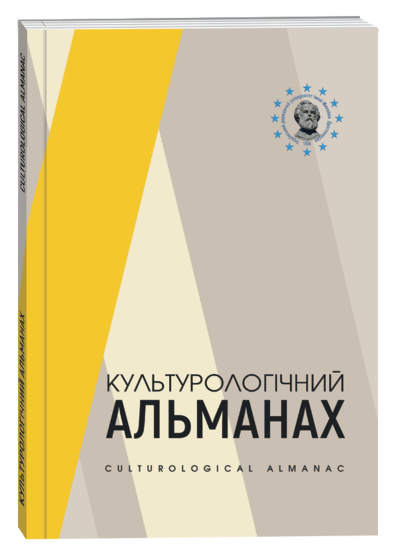MODERN ANIMATION: THE MAIN UNIVERSALS OF CULTURE, CULTURAL INVARIANTS AND VARIABILITY
DOI:
https://doi.org/10.31392/cult.alm.2022.3.29Keywords:
animation, cultural universals, cultural invariants, variabilityAbstract
Animated works in modern culture play an important role, influencing the development of other screen arts and exerting a powerful influence on the modern cultural life of society. The article attempts to research the modern art of animation in the context of cultural universals, invariants of culture and its variability. The extrapolation method was used for the research, which made it possible to optimize knowledge and draw conclusions about the features of animation and its variability through the prism of cultural universals and cultural invariants. The extrapolation method was used independently, as well as with the involvement of inductive methods and modeling methods, which made it possible to optimize knowledge and draw conclusions. An analysis of literary data was carried out, which showed that significant material has been accumulated in scientific and research literature, which reveals the essence of cultural universals and cultural invariants. Researched that the universals of culture are a kind of invariants of development, elements of culture, norms, values, rules, traditions that are inherent in all cultures. In addition, animation is viewed for the first time through the prism of cultural invariants and cultural universals. It is established that the cultural invariant appears as the unity of the changing and the unchanging, is a way of preserving and transmitting symbols, myths and archetypes in the cultural-historical tradition. A conclusion is made about the variability of the functioning of modern animation. Variability is related to the cultural characteristics of the country of animation rental. However, the universals of culture are manifested in modern animation through the general cultural values of a person, which it reproduces. Invariance is the reproduction of values that remain unchanged under varying interpretations. The variability of modern animation is related to transformational processes in culture, therefore, the functioning of modern animation is variable. Variability is related to the cultural characteristics of the country of animation rental. However, the universals of culture are manifested in modern animation through the general cultural values of a person, which it reproduces. Invariance is the reproduction of values that remain unchanged under varying interpretations.
References
Балута Г. (2012). Iнварiанти: реальне чи номiнальне? Актуальнi проблеми духовностi : зб. наук. Праць. Випуск 13. Кривий Рiг. С. 212.
Босик З. (2010). Родинна обрядовість : трансформація та архетипові мотиви весільної обрядовості Середньої Наддніпрянщини : монографія. Київ : НАКККіМ. С. 137.
Geertz C. (1983). Local Knowledge : Further Essays in Interpretive Anthropology. N.Y. : Basic Books. 244 p.
Голубович І. Інваріанти і тексти культури. Докса. Випуск 6. URL: http://doxa.onu.edu.ua/Doxa6/222-230.pdf (дата звернення: 10.11.2022).
Кирилюк А. (1996). Универсалии культуры и семиотика дискурса. Миф. Одесса : Рось. С. 143.
Hills M. D. (2002). Kluckhohn and Strodtbeck's Values Orientation Theory. Online Readings in Psychology and Culture. 4(4). URL: https://doi.org/10.9707/2307-0919.1040 (дата звернення: 10.11.2022).
Гречанівська П. Варіативність – основа розвитку народних традицій. Новий Акрополь. URL: https://newacropolis.org.ua/theses/e731c0f4-6281-4eed-9e27-ce18d365e7a0 (дата звернення: 10.11.2022).
Hills M. D. (2002). Kluckhohn and Strodtbeck's Values Orientation Theory. Online Readings in Psychology and Culture. URL: https://doi.org/10.9707/2307-0919.1040 (дата звернення: 10.11.2022).
Колесник О.С. (2013). Художня інтерпретація інваріантних образів. Міжнародний вісник: Культурологія. Філологія. Музикознавство наук. журнал. Київ : Міленіум № 1.
Жулєнова О. (2013). Культурні універсалії, інваріантність та еквівалентність: іхня роль у реалізації кроснаціональних досліджень. Соціологія: теорія, методи, маркетинг. № 3. С. 205.
Maldonado H., Hayes-Roth B. (2004). Toward Cross-Cultural Believability in Character Design, Stanford University. p. 61. URL: https://hci.stanford.edu/publications/2004/CrossCultBelievability0304/CrossCultBelievability0304.pdf (дата звернення: 10.11.2022).
Черниш М. (2013). Основні поняття та методологічні принципи культурологічного аналізу проблеми збереження культурного розмаїття. Вісник Національної академії керівних кадрів культури і мистецтв. № 2. С. 90–95. URL: http://journals.uran.ua/visnyknakkkim/article/view/137999 (дата звернення: 10.11.2022).
Штомпка П. (2005). Социология. Анализ современного общества. Москва : Логос. С. 255.








